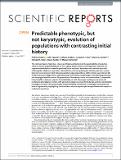Files in this item
Predictable phenotypic, but not karyotypic, evolution of populations with contrasting initial history
Item metadata
| dc.contributor.author | Simões, Pedro | |
| dc.contributor.author | Fragata, Inês | |
| dc.contributor.author | Seabra, Sofia G. | |
| dc.contributor.author | Faria, Gonçalo S. | |
| dc.contributor.author | Santos, Marta A. | |
| dc.contributor.author | Rose, Michael R. | |
| dc.contributor.author | Santos, Mauro | |
| dc.contributor.author | Matos, Margarida | |
| dc.date.accessioned | 2017-05-11T09:30:24Z | |
| dc.date.available | 2017-05-11T09:30:24Z | |
| dc.date.issued | 2017-04-19 | |
| dc.identifier | 249967882 | |
| dc.identifier | 7f2032ef-f6f7-42cb-ae11-04eb6157b5fc | |
| dc.identifier | 85018423716 | |
| dc.identifier | 000399530600010 | |
| dc.identifier.citation | Simões , P , Fragata , I , Seabra , S G , Faria , G S , Santos , M A , Rose , M R , Santos , M & Matos , M 2017 , ' Predictable phenotypic, but not karyotypic, evolution of populations with contrasting initial history ' , Scientific Reports , vol. 7 , 913 . https://doi.org/10.1038/s41598-017-00968-1 | en |
| dc.identifier.issn | 2045-2322 | |
| dc.identifier.other | RIS: Simões2017 | |
| dc.identifier.other | ORCID: /0000-0002-1511-8680/work/32706770 | |
| dc.identifier.uri | https://hdl.handle.net/10023/10747 | |
| dc.description | This study was financed by Portuguese National Funds through FCT - ‘Fundação para a Ciência e Tecnologia’ within the projects PTDC/BIA-BEC/098213/2008, PTDC/BIA-BIC/2165/2012 and cE3c Unit FCT funding UID/BIA/00329/2013. I.F. had a PhD grant (SFRH/BD/60734/2009), P.S. has a Post Doc grant (SFRH/BPD/86186/2012) and S.G.S. has a Post Doc grant (SFRH/BPD/108413/2015) from FCT. M.S. is funded by grant CGL2013-42432-P from the Ministerio de Economía y Competitividad (Spain) and grant 2014 SGR 1346 from Generalitat de Catalunya. The datasets generated during and/or analysed during the current study are available in the figshare repository, at https://doi.org/10.6084/m9.figshare.4797550. | en |
| dc.description.abstract | The relative impact of selection, chance and history will determine the predictability of evolution. There is a lack of empirical research on this subject, particularly in sexual organisms. Here we use experimental evolution to test the predictability of evolution. We analyse the real-time evolution of Drosophila subobscura populations derived from contrasting European latitudes placed in a novel laboratory environment. Each natural population was sampled twice within a three-year interval. We study evolutionary responses at both phenotypic (life-history, morphological and physiological traits) and karyotypic levels for around 30 generations of laboratory culture. Our results show (1) repeatable historical effects between years in the initial state, at both phenotypic and karyotypic levels; (2) predictable phenotypic evolution with general convergence except for body size; and (3) unpredictable karyotypic evolution. We conclude that the predictability of evolution is contingent on the trait and level of organization, highlighting the importance of studying multiple biological levels with respect to evolutionary patterns. | |
| dc.format.extent | 12 | |
| dc.format.extent | 2691225 | |
| dc.language.iso | eng | |
| dc.relation.ispartof | Scientific Reports | en |
| dc.subject | QH301 Biology | en |
| dc.subject | DAS | en |
| dc.subject.lcc | QH301 | en |
| dc.title | Predictable phenotypic, but not karyotypic, evolution of populations with contrasting initial history | en |
| dc.type | Journal article | en |
| dc.contributor.institution | University of St Andrews. School of Biology | en |
| dc.identifier.doi | 10.1038/s41598-017-00968-1 | |
| dc.description.status | Peer reviewed | en |
| dc.identifier.url | https://www.nature.com/articles/s41598-017-00968-1#supplementary-information | en |
This item appears in the following Collection(s)
Items in the St Andrews Research Repository are protected by copyright, with all rights reserved, unless otherwise indicated.

